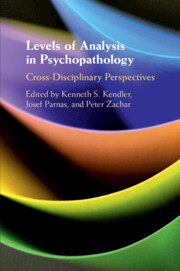Book contents
- Levels of Analysis in Psychopathology
- Advance Praise for Levels of Analysis in Psychopathology
- Levels of Analysis in Psychopathology
- Copyright page
- Contents
- Figures
- Tables
- Contributors
- Preface
- General Introduction
- Part I Neuroscience, Mechanisms, and RDoC
- Part II Phenomenology, Biological Psychology, and the Mind–Body Problem
- Part III Taxonomy, Integration, and Multiple Levels of Explanation
- Index
- References
17 - Phenomenology of a Disordered Self in Schizophrenia: Example of an Integrative Level for Psychiatric Research
from Section 6
Published online by Cambridge University Press: 02 April 2020
- Levels of Analysis in Psychopathology
- Advance Praise for Levels of Analysis in Psychopathology
- Levels of Analysis in Psychopathology
- Copyright page
- Contents
- Figures
- Tables
- Contributors
- Preface
- General Introduction
- Part I Neuroscience, Mechanisms, and RDoC
- Part II Phenomenology, Biological Psychology, and the Mind–Body Problem
- Part III Taxonomy, Integration, and Multiple Levels of Explanation
- Index
- References
Summary
Psychiatric diagnostic systems contain approximately 400 mainly descriptively defined categories with incomprehensible overlaps and comorbidity. Empirical research has demonstrated a multitude of biological, psychological, and social risk factors, which are, however, not integrated in any conceptually coherent pathogenetic model. We argue that over and above a purely superficial symptomatic description we should address the level of mental structures underlying the symptoms. We emphasize the basic ontological structures, which are conditions for human experience and existence: intentionality, selfhood, intersubjectivity, temporality, and embodiment. A structural level may serve the purposes of classification and provide an integrative bridge between biological and psychological phenomena. We concentrate upon the level of selfhood where we distinguish the structural features (the so-called core self) and the more personal language and history involving level (the ‘narrative self’). Through a review of literature and presentation of two clinical cases, we demonstrate the value of the concept in studying schizophrenia.
Keywords
Information
- Type
- Chapter
- Information
- Levels of Analysis in PsychopathologyCross-Disciplinary Perspectives, pp. 207 - 227Publisher: Cambridge University PressPrint publication year: 2020
References
Accessibility standard: Unknown
Why this information is here
This section outlines the accessibility features of this content - including support for screen readers, full keyboard navigation and high-contrast display options. This may not be relevant for you.Accessibility Information
- 1
- Cited by
